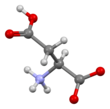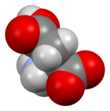
Back حمض الأسبارتيك Arabic Asparagin turşusu Azerbaijani اسید آسپارتیک AZB Аспарагінавая кіслата Byelorussian Аспарагинова киселина Bulgarian অ্যাস্পার্টিক অ্যাসিড Bengali/Bangla Asparaginska kiselina BS Àcid aspàrtic Catalan Kyselina asparagová Czech Asparaginsäure German
 Skeletal formula of L-aspartic acid
| |||
| |||
| Names | |||
|---|---|---|---|
IUPAC name
| |||
Other names
| |||
| Identifiers | |||
3D model (JSmol)
|
| ||
| ChEBI |
| ||
| ChEMBL |
| ||
| ChemSpider | |||
| DrugBank |
| ||
| ECHA InfoCard | 100.000.265 | ||
| EC Number |
| ||
| KEGG |
| ||
PubChem CID
|
|||
| UNII |
| ||
CompTox Dashboard (EPA)
|
|||
| |||
| |||
| Properties | |||
| C4H7NO4 | |||
| Molar mass | 133.103 g·mol−1 | ||
| Appearance | colourless crystals | ||
| Density | 1.7 g/cm3 | ||
| Melting point | 270 °C (518 °F; 543 K) | ||
| Boiling point | 324 °C (615 °F; 597 K) (decomposes) | ||
| 4.5 g/L[2] | |||
| Acidity (pKa) |
| ||
| Conjugate base | Aspartate | ||
| -64.2·10−6 cm3/mol | |||
| Hazards | |||
| NFPA 704 (fire diamond) | |||
| Supplementary data page | |||
| Aspartic acid (data page) | |||
Except where otherwise noted, data are given for materials in their standard state (at 25 °C [77 °F], 100 kPa).
| |||
Aspartic acid (symbol Asp or D;[4] the ionic form is known as aspartate), is an α-amino acid that is used in the biosynthesis of proteins.[5] The L-isomer of aspartic acid is one of the 22 proteinogenic amino acids, i.e., the building blocks of proteins. D-aspartic acid is one of two D-amino acids commonly found in mammals.[6][7] Apart from a few rare exceptions, D-aspartic acid is not used for protein synthesis but is incorporated into some peptides and plays a role as a neurotransmitter/neuromodulator.[6]
Like all other amino acids, aspartic acid contains an amino group and a carboxylic acid. Its α-amino group is in the protonated –NH+
3 form under physiological conditions, while its α-carboxylic acid group is deprotonated −COO− under physiological conditions. Aspartic acid has an acidic side chain (CH2COOH) which reacts with other amino acids, enzymes and proteins in the body.[5] Under physiological conditions (pH 7.4) in proteins the side chain usually occurs as the negatively charged aspartate form, −COO−.[5] It is a non-essential amino acid in humans, meaning the body can synthesize it as needed. It is encoded by the codons GAU and GAC.
In proteins aspartate sidechains are often hydrogen bonded to form asx turns or asx motifs, which frequently occur at the N-termini of alpha helices.
Aspartic acid, like glutamic acid, is classified as an acidic amino acid, with a pKa of 3.9; however, in a peptide this is highly dependent on the local environment, and could be as high as 14.
The one-letter code D for aspartate was assigned arbitrarily,[8] with the proposed memnonic asparDic acid.[9]
- ^ Budavari, Susan; Co, Merck (1989). "862. Aspartic acid". The Merck Index (11th ed.). Merck. p. 132. ISBN 978-0-911910-28-5.
- ^ "ICSC 1439 - L-ASPARTIC ACID". inchem.org.
- ^ Haynes, William M., ed. (2016). CRC Handbook of Chemistry and Physics (97th ed.). CRC Press. pp. 5–89. ISBN 978-1498754286.
- ^ "Nomenclature and Symbolism for Amino Acids and Peptides". IUPAC-IUB Joint Commission on Biochemical Nomenclature. 1983. Archived from the original on 9 October 2008. Retrieved 5 March 2018.
- ^ a b c G., Voet, Judith; W., Pratt, Charlotte (2016-02-29). Fundamentals of biochemistry : life at the molecular level. John Wiley & Sons. ISBN 9781118918401. OCLC 910538334.
{{cite book}}: CS1 maint: multiple names: authors list (link) - ^ a b D'Aniello, Antimo (1 February 2007). "d-Aspartic acid: An endogenous amino acid with an important neuroendocrine role". Brain Research Reviews. 53 (2): 215–234. doi:10.1016/j.brainresrev.2006.08.005. PMID 17118457. S2CID 12709991.
- ^ Huang AS, Beigneux A, Weil ZM, Kim PM, Molliver ME, Blackshaw S, Nelson RJ, Young SG, Snyder SH (March 2006). "D-aspartate regulates melanocortin formation and function: behavioral alterations in D-aspartate oxidase-deficient mice". The Journal of Neuroscience. 26 (10): 2814–9. doi:10.1523/JNEUROSCI.5060-05.2006. PMC 6675153. PMID 16525061.
- ^ "IUPAC-IUB Commission on Biochemical Nomenclature A One-Letter Notation for Amino Acid Sequences". Journal of Biological Chemistry. 243 (13): 3557–3559. 10 July 1968. doi:10.1016/S0021-9258(19)34176-6.
- ^ Adoga, Godwin I; Nicholson, Bh (January 1988). "Letters to the editor". Biochemical Education. 16 (1): 49. doi:10.1016/0307-4412(88)90026-X.
© MMXXIII Rich X Search. We shall prevail. All rights reserved. Rich X Search


